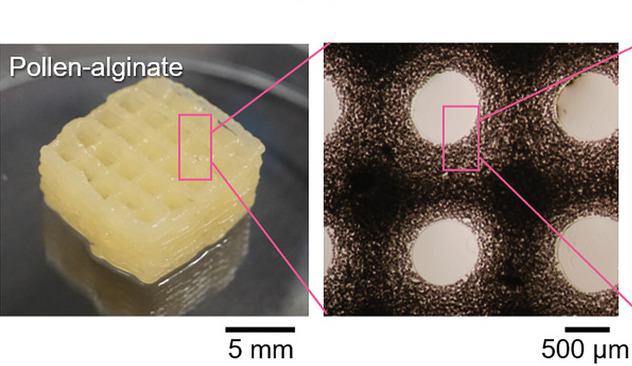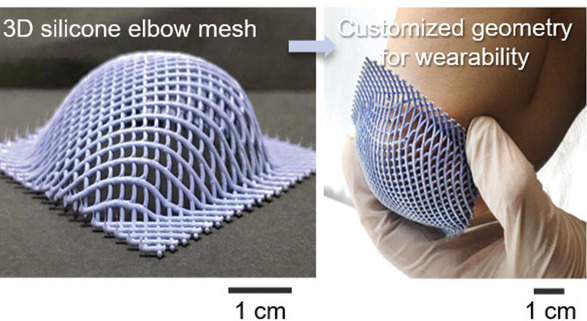The nominations for the 2021 3D Printing Industry Awards are now open. Who do you think should make the shortlists for this year’s show? Have your say now.
Researchers at Nanyang Technological University (NTU) have developed a sunflower extract-loaded 3D bioprinting ink that could yield a new generation of biomedical devices.
Unlike ordinary malleable bio-inks, the team’s pollen-based creation can be tuned to lend it greater rigidity, thus it’s capable of being 3D printed into structures without losing its integrity between layers. Having already used their ink to produce tissue-regenerative cell scaffolds, the scientists now believe it to have significant potential within tissue engineering, toxicity testing and drug delivery applications.
“Bioprinting can be challenging because the material of the inks used is typically too soft, which means the structure of the envisioned product may collapse during printing,” explained the study’s co-lead author Cho Nam-Joon. “Through tuning the mechanical properties of sunflower pollen, we developed a pollen-based hybrid ink that can be used to print structures with good structural integrity.”
“Given that there are numerous types of pollen species, pollen microgel suspensions could potentially be used to create a new class of eco-friendly 3D printing materials.”

Beefing-up bioprinted hydrogels
Due to its inherent ability to incorporate living cells, Direct Ink Writing (DIW) 3D printing has become an increasingly popular means of creating biomedical devices like tissue scaffolds. Likewise, hydrogels are often used within DIW because they’re customizable, they facilitate cell attachment, and they’re capable of accurately mimicking biological tissues.
However, according to the NTU researchers, hydrogels are also characterized by low mechanical stability and bioinertness, necessitating the creation of a ‘hybrid’ ink that “provides functions and properties not attainable by any single hydrogel.”
In the past, some scientists have found that integrating nano-fibers or nano-platelets into hydrogel bio-inks solidifies them, and stops them clogging a printer’s nozzles. Others have developed supporting matrices, composed of hydrogels, cells and rubber, that help preserve printed structures before they’re fully-cured, while offering enhanced stability and sustainability due to their reusable ingredients.
Taking inspiration from the latter, the NTU team has therefore created a microgel suspension from renewable pollen grains. Given its uniform size, as well as its tunable and consistent rheological behavior, the scientists say that pollen yields ideal supporting matrices, and that its stimulus-responsive nature could lend it potential drug delivery capabilities.

Pollen-based biomedical devices
To create their new bio-ink, the researchers started by using a method akin to soapmaking to turn sunflower pollen into a microgel suspension. This was then mixed with alginate, rubber and hyaluronic acid, yielding a blend composed of pollen grains with a softer outer layer than normal, allowing them to be compressed into a printer’s nozzle without jamming it.
In fact, during early testing, the scientists found they were able to extrude their bio-ink with any given volume of pollen content, without clogging up their 3D printer. Having demonstrated the initial viability of their material by producing multilayered microstructures, the team then went on to fabricate dye-loaded scaffolds, to assess its drug delivery potential.
Interestingly, the amount of dye released during these experiments changed over time, thus thanks to pollen’s stimuli responsive nature, the bio-ink could be tuned to release drugs according to patient-specific dosages. Given that pollen is also biocompatible, the researchers were able to load their scaffolds with cells as well, producing a five-layer structure that exhibited 94% cell viability.

Finally, the team increased the rubber and alginate content of their ink in order to test its ability to produce more conventional biomedical devices like supports. In practise, this meant creating a ‘silicone rubber mesh dome’ device, which the scientists say “exhibited good structural fidelity” and “enhanced printing resolution,” thanks to its pollen base.
Moving forwards, the researchers intend to optimize their suspension further by improving its recyclability after multiple heat cycles, but they already view it as a viable way of avoiding printing jamming while 3D printing, and given its stimuli-responsive behavior, they say it could be an “abundant and affordable starting material” for future biomedical applications.
“Our findings could open new doors to customized flexible membranes that fit the human skin’s contours exactly, such as wound dressing patches or facial masks,” concluded study co-author Song Juha. “Using our ink, which is biocompatible, flexible and low in cost, we can fabricate membranes that are tailored to the contours of the human skin, and are capable of bending without breaking.”
Rise of the bio-inspired material
As the 3D printing industry continues to search for eco-friendly alternatives to oil-based polymers, scientists have increasingly turned to mother nature for answers. Researchers at the Portuguese University of Aveiro and Aveiro Institute of Materials, for instance, recently developed a bamboo-based ABS material that they say yields “enhanced quality parts.”
At the Federal Institute for Materials Research and Testing, scientists have turned to insects, by converting termite refuse into a unique binder jet printing material. Although the feedstock has initially showed a low level of strength, its designers maintain that in future, it can be used to create highly-accurate filigree structures.
Elsewhere, researchers have embraced mother nature’s designs rather than her raw ingredients, like the team at Kiel University, who have 3D printed dragonfly-inspired ‘spiky joints.’ Like the NUT scientists’ biomedical test devices, the Kiel team’s is ultra-strong, but its design also makes it flexible and robust enough to merit end-use application.
The researchers’ findings are detailed in their paper titled “Engineering Natural Pollen Grains as Multifunctional 3D Printing Materials.” The study was co-authored by Shengyang Chen, Qian Shi, Taesik Jang, Mohammed Shahrudin Bin Ibrahim, Jingyu Deng, Gaia Ferracci, Wen See Tan, Nam-Joon Cho and Juha Song.
The nominations for the 2021 3D Printing Industry Awards are now open. Who do you think should make the shortlists for this year’s show? Have your say now.
To stay up to date with the latest 3D printing news, don’t forget to subscribe to the 3D Printing Industry newsletter or follow us on Twitter or liking our page on Facebook.
For a deeper dive into additive manufacturing, you can now subscribe to our Youtube channel, featuring discussion, debriefs, and shots of 3D printing in-action.
Are you looking for a job in the additive manufacturing industry? Visit 3D Printing Jobs for a selection of roles in the industry.
Featured image shows a close-up of a bee collecting pollen from a flower. Image via Karolina Grabowska, Pexels.


